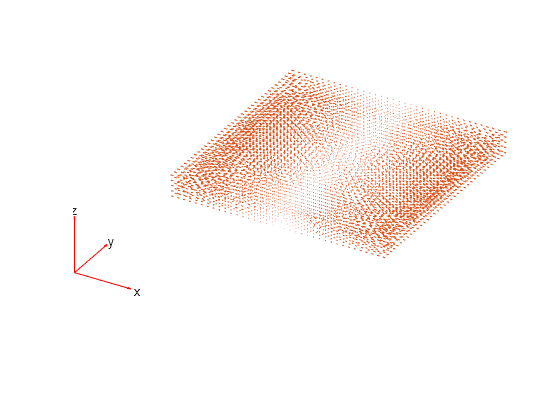interpolateCurrentDensity
Interpolate current density in DC conduction result at arbitrary spatial locations
Since R2022b
Syntax
Description
Examples
Create an femodel object for DC conduction analysis and include a 2-D geometry of a plate with a hole into the model.
model = femodel(AnalysisType="dcConduction", ... Geometry="PlateHolePlanar.stl");
Plot the geometry.
pdegplot(model.Geometry,EdgeLabels="on");
Specify the conductivity of the material.
model.MaterialProperties = ...
materialProperties(ElectricalConductivity=6e4);Apply the voltage boundary conditions on the top and bottom edges of the plate.
model.EdgeBC(3) = edgeBC(Voltage=100); model.EdgeBC(2) = edgeBC(Voltage=200);
Specify the surface current density on the edge representing the hole.
model.EdgeLoad(5) = edgeLoad(SurfaceCurrentDensity=200000);
Generate a mesh.
model = generateMesh(model);
Solve the problem.
R = solve(model);
Plot the electric potential and current density.
figure pdeplot(R.Mesh,XYData=R.ElectricPotential,ColorMap="jet", ... FlowData=[R.CurrentDensity.Jx R.CurrentDensity.Jy]) axis equal

Interpolate the resulting current density to a grid covering the central portion of the geometry.
[X,Y] = meshgrid(2:0.25:8,8:0.25:12); Jintrp = interpolateCurrentDensity(R,X,Y)
Jintrp =
FEStruct with properties:
Jx: [425×1 double]
Jy: [425×1 double]
Reshape Jintrp.Jx and Jintrp.Jy, and plot the resulting current density.
JintrpX = reshape(Jintrp.Jx,size(X)); JintrpY = reshape(Jintrp.Jy,size(Y)); quiver(X,Y,JintrpX,JintrpY,Color="red") axis equal

Alternatively, you can specify the grid by using a matrix of query points.
querypoints = [X(:),Y(:)]'; Jintrp = interpolateCurrentDensity(R,querypoints);
Create an femodel object for DC conduction analysis and include a geometry representing a 10-by-10-by-1 solid plate into the model.
model = femodel(AnalysisType="dcConduction", ... Geometry="Plate10x10x1.stl");
Plot the geometry.
pdegplot(model.Geometry,FaceLabels="on",FaceAlpha=0.3)
Specify the conductivity of the material.
model.MaterialProperties = ...
materialProperties(ElectricalConductivity=6e4);Apply the voltage boundary conditions on the two faces of the plate.
model.FaceBC([1 3]) = faceBC(Voltage=0);
Specify the surface current density on the top of the plate.
model.FaceLoad(5) = faceLoad(SurfaceCurrentDensity=100);
Generate a mesh.
model = generateMesh(model);
Solve the problem.
R = solve(model);
Plot the electric potential.
figure pdeplot3D(R.Mesh,ColorMapData=R.ElectricPotential)

Plot the current density.
figure pdeplot3D(R.Mesh,FlowData=[R.CurrentDensity.Jx, ... R.CurrentDensity.Jy, ... R.CurrentDensity.Jz])

Interpolate the resulting current density to a coarser grid.
[X,Y,Z] = meshgrid(0:10,0:10,0:0.5:1); Jintrp = interpolateCurrentDensity(R,X,Y,Z)
Jintrp =
FEStruct with properties:
Jx: [363×1 double]
Jy: [363×1 double]
Jz: [363×1 double]
Reshape Jintrp.Jx, Jintrp.Jy, and Jintrp.Jz.
JintrpX = reshape(Jintrp.Jx,size(X)); JintrpY = reshape(Jintrp.Jy,size(Y)); JintrpZ = reshape(Jintrp.Jz,size(Z));
Plot the resulting current density.
figure
quiver3(X,Y,Z,JintrpX,JintrpY,JintrpZ,Color="red")
Input Arguments
Solution of a DC conduction problem, specified as a ConductionResults
object. Create results using the solve
function.
x-coordinate query points, specified as a real array.
interpolateCurrentDensity evaluates the current density at the 2-D
coordinate points [xq(i) yq(i)] or at the 3-D coordinate points
[xq(i) yq(i) zq(i)] for every i. Because of
this, xq, yq, and (if present)
zq must have the same number of entries.
interpolateCurrentDensity converts the query points to column
vectors xq(:), yq(:), and (if present)
zq(:). It returns current density values as a column vector of the
same size. To ensure that the dimensions of the returned solution are consistent with
the dimensions of the original query points, use reshape. For
example, use Jintrp = reshape(Jintrp,size(xq)).
Example: xq = [0.5 0.5 0.75 0.75]
Data Types: double
y-coordinate query points, specified as a real array.
interpolateCurrentDensity evaluates the current density at the 2-D
coordinate points [xq(i) yq(i)] or at the 3-D coordinate points
[xq(i) yq(i) zq(i)] for every i. Because of
this, xq, yq, and (if present)
zq must have the same number of entries.
interpolateCurrentDensity converts the query points to column
vectors xq(:), yq(:), and (if present)
zq(:). It returns current density values as a column vector of the
same size. To ensure that the dimensions of the returned solution are consistent with
the dimensions of the original query points, use reshape. For
example, use Jintrp = reshape(Jintrp,size(yq)).
Example: yq = [1 2 0 0.5]
Data Types: double
z-coordinate query points, specified as a real array.
interpolateCurrentDensity evaluates the current density at the 3-D
coordinate points [xq(i) yq(i) zq(i)]. Therefore,
xq, yq, and zq must have
the same number of entries.
interpolateCurrentDensity converts the query points to column
vectors xq(:), yq(:), and
zq(:). It returns current density values as a column vector of the
same size. To ensure that the dimensions of the returned solution are consistent with
the dimensions of the original query points, use reshape. For
example, use Jintrp = reshape(Jintrp,size(zq)).
Example: zq = [1 1 0 1.5]
Data Types: double
Query points, specified as a real matrix with either two rows for 2-D geometry or
three rows for 3-D geometry. interpolateCurrentDensity evaluates the
current density at the coordinate points querypoints(:,i) for every
i, so each column of querypoints contains
exactly one 2-D or 3-D query point.
Example: For a 2-D geometry, querypoints = [0.5 0.5 0.75 0.75; 1 2 0
0.5]
Data Types: double
Output Arguments
Current density at query points, returned as an FEStruct object
with the properties representing the spatial components of the current density at the
query points. For query points that are outside the geometry,
Jintrp.Jx(i), Jintrp.Jy(i), and
Jintrp.Jz(i) are NaN. Properties of an
FEStruct object are read-only.
Version History
Introduced in R2022b
See Also
Objects
Functions
MATLAB Command
You clicked a link that corresponds to this MATLAB command:
Run the command by entering it in the MATLAB Command Window. Web browsers do not support MATLAB commands.
웹사이트 선택
번역된 콘텐츠를 보고 지역별 이벤트와 혜택을 살펴보려면 웹사이트를 선택하십시오. 현재 계신 지역에 따라 다음 웹사이트를 권장합니다:
또한 다음 목록에서 웹사이트를 선택하실 수도 있습니다.
사이트 성능 최적화 방법
최고의 사이트 성능을 위해 중국 사이트(중국어 또는 영어)를 선택하십시오. 현재 계신 지역에서는 다른 국가의 MathWorks 사이트 방문이 최적화되지 않았습니다.
미주
- América Latina (Español)
- Canada (English)
- United States (English)
유럽
- Belgium (English)
- Denmark (English)
- Deutschland (Deutsch)
- España (Español)
- Finland (English)
- France (Français)
- Ireland (English)
- Italia (Italiano)
- Luxembourg (English)
- Netherlands (English)
- Norway (English)
- Österreich (Deutsch)
- Portugal (English)
- Sweden (English)
- Switzerland
- United Kingdom (English)